Content Marketing Plan: The 10-Step Framework to Build One
Is your content marketing plan all over the place?
Let’s picture this. You’ve started an online marketing course and you need to promote your business.
You’ll devise a concrete content marketing plan for promoting your business. Alas, your strategy failed!
Maybe because of undefined content marketing plan goals, inappropriate keywords used within the content or other missing pieces of content strategy.
Thinking about what those missing pieces can be? We’ve covered it all.
In this article, you’ll learn our comprehensive 10-step framework for building your content marketing plan.
10-Step Framework for Building a Content Marketing Plan
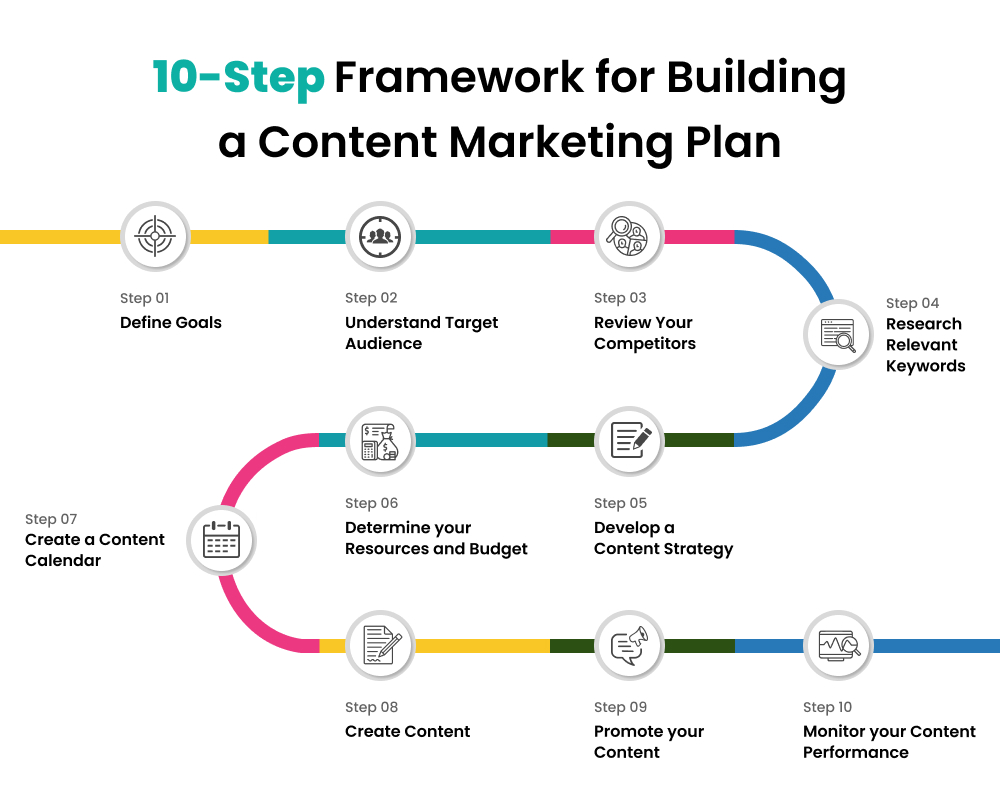
1. Define Goals for the Content Marketing Plan
The initial phase of building a content marketing plan involves defining its goals. It consists of the mission statement and business goals that you wish to achieve.
Your content marketing plan’s mission statement outlines:
- Target audience
- Content to be used to target them
- Benefits your target audience will gain from it.
Here’s an example from Mastroke’s About Us page:
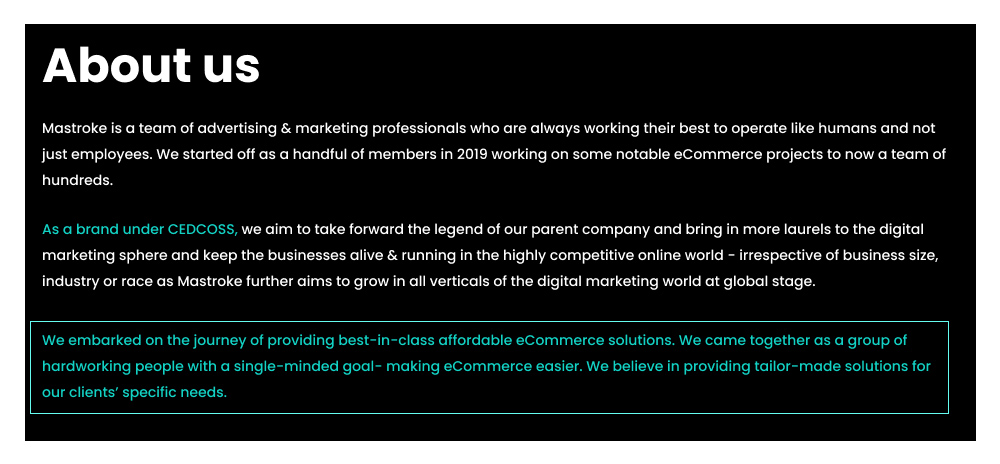
As shown in the above image, About Us of Mastroke highlights benefits (providing best-in-class affordable eCommerce solutions, making eCommerce easier) in its mission statement.
Besides your mission statement, a few goals that you can define for your business are-
- Improving sales and revenue.
- Increasing website traffic.
- Enhancing social media engagement.
- Reducing marketing expenses.
2. Understand the Target Audience as per the Content Marketing Plan
After defining goals, you need to be clear about your target audience. This helps in attracting the right audience as per your marketing goals.
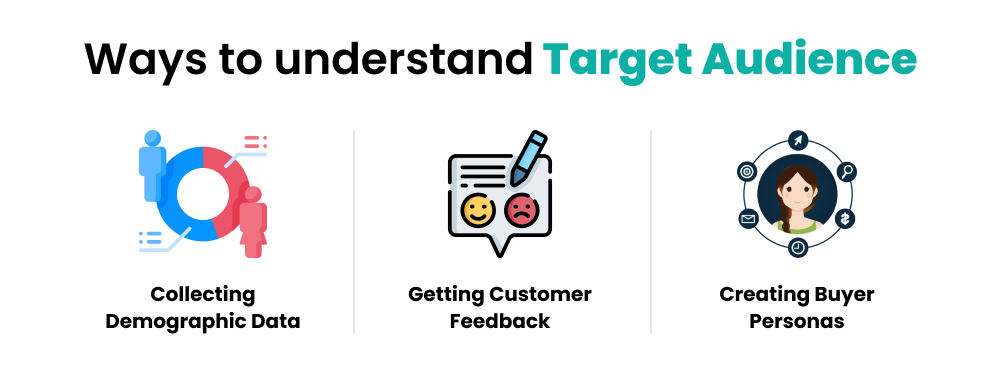
The three steps to understanding the target audience are:
-
Collecting Demographic Data
Initially utilize social media analytics, web analytics and email subscriber analytics to get data about your target audience.
You can collect their demographic information based on:
- 1. Gender
- 2. Age
- 3. Financial status
- 4. Education background
- 5. Location
-
Getting Customer Feedback
This aids in getting a deeper understanding of your audience’s needs. You get insights on:
- Pain points of your customers
- What do they feel about your content?
- What changes can you make to your content?
- How can you address their concerns?
-
Creating Buyer Personas
After collecting demographic information and customer feedback, you can work on creating buyer personas. Also known as customer avatar, it defines your ideal customers.
A few benefits of creating buyer personas are:
- Identification of your customer needs and wants
- Understanding purchase decisions
- Content targeting
- Insights into the behavior of customers
3. Review Your Competitors for Your Content Marketing Plan
The next step involves researching your competitors. Gain an understanding of:
- Competitors who are targeting a similar audience like you and share your industry.
- Content format types that your competitors are focusing on, for example, podcasts, videos, blogs and newsletters.
- Performance of competitors’ content based on metrics like website traffic and backlink gaps. Tools like Semrush and SpyFu can help you determine your competitor’s content performance.
- Content gaps- This includes content ideas that your competitors have uncovered. You can include these ideas in your content marketing plan to fill the content gaps.
- Engagement metrics- Analyse the engagement metrics in the form of likes, comments and shares on your competitors’ posts. Know about the ‘why’ behind a post’s engagement. This will help you to work better on the engagement for your content.
These insights can help in more efficient content marketing planning.
4. Research Relevant Keywords
After researching your competitors’ content and their strategies, you can begin by researching relevant keywords for your content. This aids you in knowing what your target audience is looking for online.
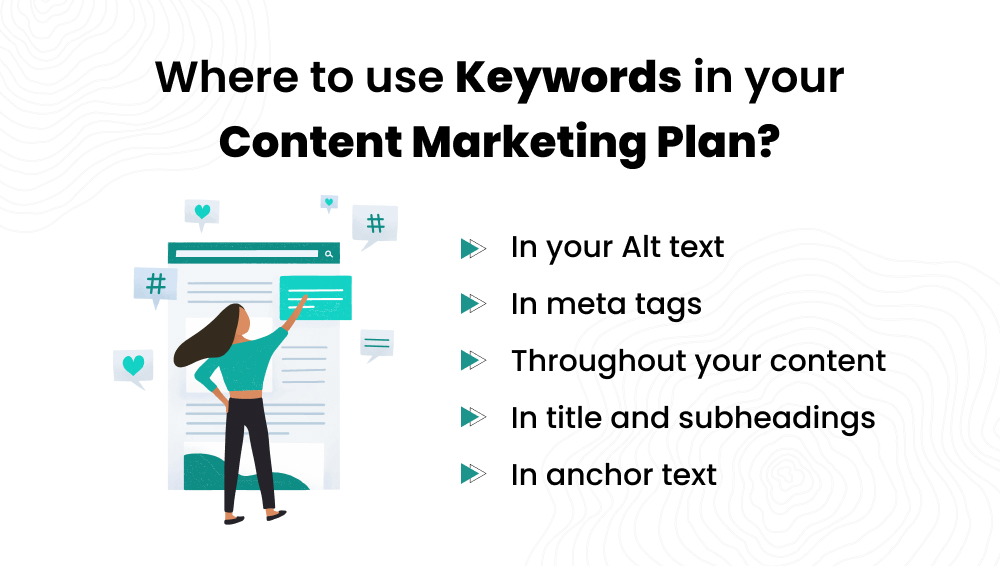
Some of the pointers to consider while researching relevant keywords are:
- Understanding what keyword terms your audience might be looking for while searching for your service or product. For example, for an online marketing course, your target audience can look for ‘online marketing course for beginners’ and ‘online marketing course with certificates.’
- Find related keywords for a focus keyword using tools like Ahrefs, SEMRush and Google Keyword Planner. You can get a detailed list of keywords along with their search volume and keyword density.
- Incorporate keywords with high search volume and low keyword difficulty within your content for better content ranking on search engines.
- Try to use long-tail keywords besides primary keywords since they have a higher conversion rate.
- Ensure to understand your keyword’s intent whether that is transactional, informational, navigational or commercial.
5. Develop a Content Strategy
The next step involves ‘how to create a content marketing strategy?’ It focuses on a few essential elements which are:
-
Content Pillars
This includes specific themes or topics your content will focus on. Ensure that it is interesting and relevant to your business.
For example, some of the content pillars for an online marketing course include:
- Fundamentals of Digital Marketing
- Search Engine Optimization
- Social Media Marketing
- Email Marketing
-
Content Clusters
Under each content pillar, we need to have a content cluster for a deep understanding of a topic.
For example, the content cluster for the above content pillars can be:
Fundamentals of Digital Marketing-
- What is Digital Marketing?
- What are KPIs and Marketing Metrics?
Search Engine Optimization-
- What is On-Page SEO?
- What is Off-Page SEO?
-
Content Types
A well-balanced content strategy should focus on a variety of content types like videos, infographics, blog posts, newsletters and podcasts.
-
Distribution Channels
After selecting the content types, you must focus on the right distribution channels for your content. Depending on where your target audience will engage more with your content, you can use email, social media or a website as your content channel.
-
Publishing Frequency
Your content’s publishing frequency affects the rate of impressions with your content.
Using tools like Google Analytics, you can measure your audience’s engagement and adjust your publishing frequency accordingly.
6. Determine your Resources for Your Content Marketing Plan
After working on your content strategy, your next step is to determine appropriate resources for your content marketing plan.
For that, you need to identify resources (both digital and human) to manage the content creation process. You can hire as a marketing professional or an e-commerce owner:
- In-house content writers
- Graphic designers
- Video editors
- Social media managers
- Content marketer
to smoothen your content creation process.
In addition, consider having a budget for your resources. This will include:
- Costs involved in content creation
- Budget for promoting content
- Outsourcing costs- If you want to hire a digital agency or freelancers, then this additional cost needs to be considered in your budget.
7. Create a Content Calendar
You need to have the contents of a marketing plan in place for creating a calendar. Some non-negotiable parts of your content calendar are:
- Date of publishing
- Publishing platform
- Content type
- The topic of your content
- Deadline for content creation
- Name of team members responsible for creating content
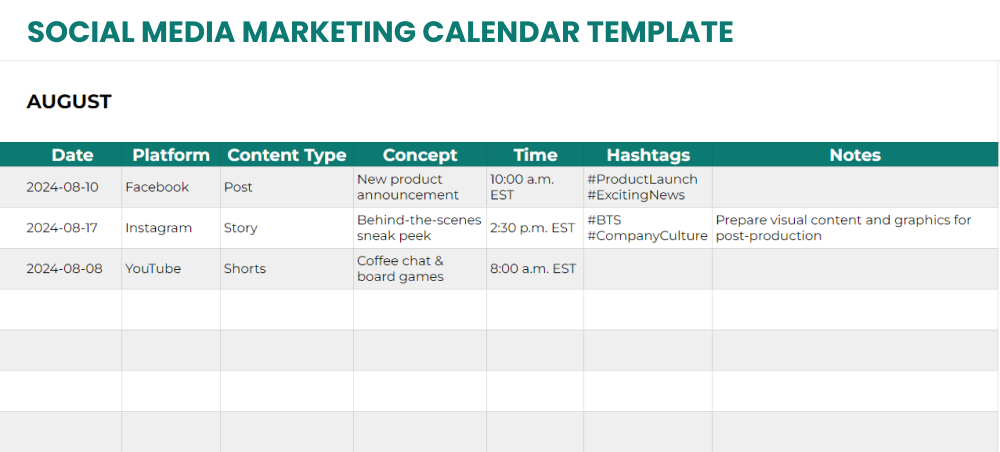
Depending on content channels, you can create a content calendar for social media, website blog posts or email marketing.
Some tips to keep in mind when creating a content calendar are:
- Utilize tools like Trello and Asana to create your content calendar.
- Brainstorm on seasonal topics to create content on, for example- Holiday marketing ideas, Black Friday Sales and Thanksgiving events.
- Leave scope for flexibility in your content calendar for last-minute changes.
- Plan your content calendar at least a month before posting on social media platforms.
8. Create Content
Once you’ve got a content calendar for your content marketing plan in place, you can start with content creation.
How to Work on Different Content Types?
- Blogs- While writing blog posts for your blog, keep a balance of trending and evergreen content topics. Use bullet points, sub-headings, and supported visuals to make your blog post more appealing to your readers.
- Infographics- Keep your infographics simple to understand with engaging visuals.
- Videos- Use storytelling to keep your viewers engaged throughout your videos. You can also include proper CTAs (call to action) towards the end of your video content.
Bonus Tips for Creating High-Quality Content
- Your content should address your target audience’s pain points and needs in detail.
- Ensure you provide valuable content to your audience.
- Incorporate different content formats like videos, blogs and reels to keep your audience hooked to your content.
- Show authenticity in your content to build credibility with your audience.
- Use a clear and strong call to action at the end of your content.
9. Promote your Content
Closed mouths don’t get fed. Likewise, your content requires promotion to get attention from its target audience.
Some of the ways by which you can promote your content are:
- Email marketing- You can share your content with your subscribers with the help of newsletters.
- Social media marketing- Promote your content on different social media platforms. Ensure that your content is relevant to a particular social media platform.
- Collaboration with industry influencers- In this age of influencer marketing, make the best use of it by promoting your content by collaborating with industry experts.
- Hiring digital marketing experts for paid advertising- Utilize meta and Google ads to increase your content’s reach.
- Conducting podcasts to promote your content- Use podcast platforms like Apple Podcasts and Audible to conduct podcasts for your content promotion.
10. Monitor your Content Marketing Plan’s Success
Lastly, regular monitoring of your content marketing plan’s performance helps in making the required changes.
A few of the things that you need to monitor are:
- Engagement metrics- This includes bounce rate, shares of your social media posts, user engagement time with your website page and comments on your blog posts.
- SEO Performance- It gives insights on keyword rankings, backlink gaps, keyword gaps and organic traffic of your website.
- Return on Investment (RoI)- You can get a comparison between the cost involved in content marketing efforts and the revenue generated for your RoI.
- Conversion Rates- This denotes the percentage of users signing up for your products or services after engaging with your content.
How can you monitor the above Metrics?
Some of the tools that can help in monitoring your metrics are:
- Social Media Analytics- There are built-in tools on social media platforms like LinkedIn, Meta, X and Instagram for tracking impressions and engagement.
- Microsoft Clarity- You can get insights regarding users’ behavior with your website using this tool.
- Mailchimp- It can help track click-through rates, open rates and conversions from email campaigns.
- Google Search Console- You can use it to understand how your website is performing.
While developing a content marketing strategy, keep monitoring your success regularly. You can modify your content based on what’s not working during this process.
Conclusion
Summing it up, you can follow all the above-mentioned steps to create efficient content marketing plans for your business. Mastroke’s Content Marketing services can also ease your task of creating a content marketing strategy.
Remember, content marketing strategy is an iterative journey that requires regular adjustments. Stay committed to presenting your values to your audience. This will yield impressive results in building engagement with your audience in due time.
You can sign up for Mastroke newsletters via your email ID to read more about such articles. You can also learn more about our digital marketing services by contacting us here.
